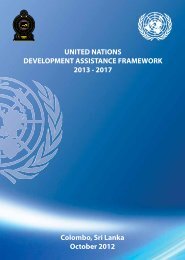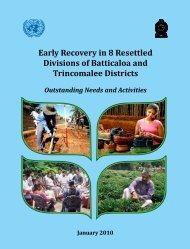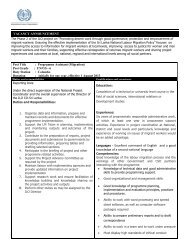Sri Lanka Human Development Report 2012.pdf
Sri Lanka Human Development Report 2012.pdf
Sri Lanka Human Development Report 2012.pdf
You also want an ePaper? Increase the reach of your titles
YUMPU automatically turns print PDFs into web optimized ePapers that Google loves.
14 percent of <strong>Sri</strong> <strong>Lanka</strong>’s population aged 25 and above<br />
was formally educated up to the A-Level in 2009,<br />
while 30 percent passed O-Level exams (Table 4.9).<br />
At the educational level demarcated by O- and A-level<br />
examinations, there was a slight difference in favor of<br />
females on both.<br />
The distribution of educated people varies widely across<br />
the country. In 2009, almost half of the estate population<br />
aged 25 and above was educated below the primary level,<br />
compared to one-sixth of the rural population and 11<br />
percent of the urban population. By junior secondary<br />
level, these differences increased significantly in favor of<br />
the urban population, a trend affirmed in pass rates on<br />
national examinations. Thirty-eight percent of people in<br />
urban areas aged 25 and above had passed the O-Level<br />
examination, compared to 29 percent of people in rural<br />
areas. A fifth of the urban population had passed the<br />
A-Level examination, but only 13 percent of the rural<br />
population had done so. On the estates, performance on<br />
both examinations was dismal: A mere 6 and 3 percent of<br />
people passed O-Level and A-Level exams, respectively.<br />
Nationally, the Western Province was at the top of the<br />
educational ladder in 2009, with 39 percent and 18<br />
percent of its population having passed the O-Level and<br />
A-Level exams, respectively. The Northern Province was<br />
the lowest performer, with about 17 percent and 9 percent<br />
of people passing these, respectively. By socioeconomic<br />
group, the poorest quintile fares the worst, at 10 percent<br />
and 3 percent, respectively. For the richest quintile, 55<br />
percent passed the O-Level exam, while almost a third<br />
passed the A-Level.<br />
Table 4.9: Highest Level of Formal Education Completed by People 25 Years and Above, 2009<br />
Below<br />
primary<br />
Primary<br />
Junior<br />
secondary<br />
Passed<br />
O-Level<br />
Passed<br />
A-Level<br />
Total<br />
National 18 25 28 16 14 100<br />
Male 16 27 28 16 13 100<br />
Female 19 23 28 16 14 100<br />
Urban 11 23 26 18 20 100<br />
Rural 17 25 29 16 13 100<br />
Estate 46 32 16 3 3 100<br />
Western 9 23 28 21 18 100<br />
Central 23 25 26 13 13 100<br />
Southern 21 22 27 17 14 100<br />
Northern 13 39 30 9 8 100<br />
Eastern 29 28 20 13 10 100<br />
North Western 19 29 27 14 11 100<br />
North Central 16 26 35 13 10 100<br />
Uva 29 23 27 13 8 100<br />
Sabaragamuwa 22 23 33 11 12 100<br />
Poorest quintile 32 31 27 7 3 100<br />
2nd quintile 22 30 31 11 6 100<br />
3rd quintile 18 27 30 15 10 100<br />
4th quintile 12 22 30 21 16 100<br />
Richest quintile 7 16 23 23 32 100<br />
Source: Computations by the report team of the Institute of Policy Studies of <strong>Sri</strong> <strong>Lanka</strong> using Department of Census<br />
and Statistics of <strong>Sri</strong> <strong>Lanka</strong> 2010c.<br />
Note: Education levels are in hierarchical order. Completion of a particular level of education implies the completion<br />
of all levels below it.<br />
Chapter 4 Bridging <strong>Human</strong> <strong>Development</strong> Gaps: EDUCATION 73






